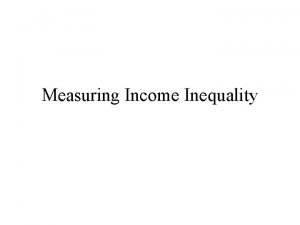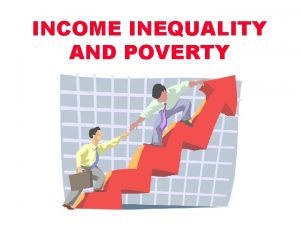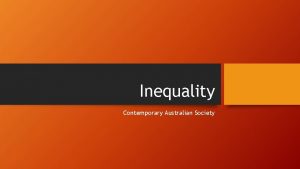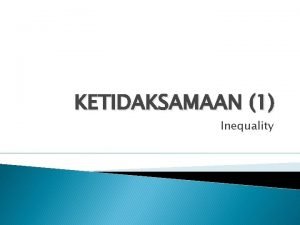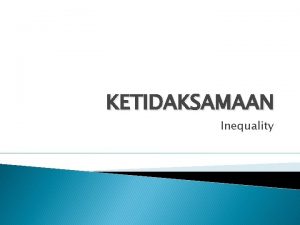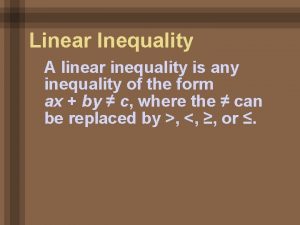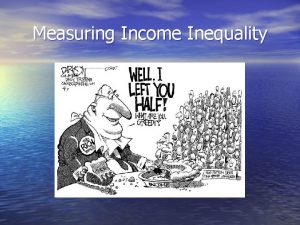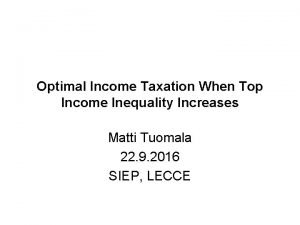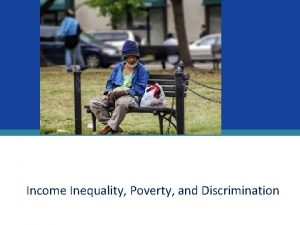INCOME INEQUALITY Income Inequality HOW TO NARROW THE

















- Slides: 17

INCOME INEQUALITY Income Inequality HOW TO NARROW THE GAP BETWEEN THE RICH AND THE POOR? 1

WHAT IS INCOME? • Income is the flow of money into the household from employment, state transfers, rents, and earnings from investments. • Disposable Income is that income after taxes which can be used for consumption or saving. 2

WHAT IS INCOME INEQUALITY? Share of Aggregate Income Received by Each Fifth of Households, All Races: 1974 to 2014 Shares of aggregate income Year Lowest Second Third Fourth Highest fifth fifth 2014 3. 1 8. 2 14. 3 23. 2 51. 2 2004 3. 4 8. 7 14. 7 23. 2 50. 1 1994 3. 6 8. 9 15. 0 23. 4 49. 1 1984 4. 0 9. 9 16. 3 24. 6 45. 2 1974 4. 3 10. 6 17. 0 24. 6 43. 5 • Income inequality refers to the extent to which income is distributed in an uneven manner among a population. • The table shows the percentage of total income that the poorest fifth of households receive to percentage of income the richest fifth of households receive. For example, in 2014 the poorest fifth of households received 3. 1% of total income; the richest fifth 51. 2%. *Source: U. S. Census Bureau, Current Population Survey, Annual Social and Economic Supplements. 3

MEASUREMENT OF INCOME INEQUALITY • • • The Gini index is a measurement of the income distribution of a country's households. This index ranges between 0 and 1. 1 indicates a single household has all of the income, 0 indicates every household has the same income. https: //fred. stlouisfed. org/graph/? g=59 ML 4

GLOBAL GINI INDEX COMPARISON Two U. S. Income Gini Coefficients: (1) Income before taxes are taken out and benefits (Social Security and welfare) are distributed / (2) Income after taxes are paid and benefits allocated: . 499/. 380 Placing the U. S. 10 th and 2 nd in income inequality among OECD countries respectively. This indicates our tax and income safety system does little to improve the disparity in household income. • • • Country GINI Values Ireland. 591/. 331 Britain. 523/. 341 France. 505/. 303 Germany. 492/. 286 Japan. 488/. 336 Canada. 447/. 320 Sweden. 441/. 269 Norway. 423/. 249 South Korea. 342/. 311 OECD Rank 1/10 3/9 7/17 11/20 12/8 23/11 24/22 28/29 31/15 *Source, http: //www. oecd. org/els/soc/income-distribution-database. htm 5

HOW DOES INCOME INEQUALITY AFFECT SOCIETY? INCOME GROUP BEHAVIOR The Poor: May affect their ability to invest in education and lower health levels. The Middle Class: May affect consumption of goods and services The Rich: May exercise political power to defeat policies that don’t fit their needs (public health and education) INCOME GROUP INTERACTION Social Capital: The poor are increasingly trapped while the rich may be exclusionary. Social Unrest: Can be associated with social conflict and higher security costs. Volatility: Hard to reach political consensus and leaders serve the interests of their supporters at the expense of public good. *Keeley, B. (2015), Income Inequality: The Gap between Rich and Poor, OECD Publishing, Paris 6

CAUSES OF INCOME INEQUALITY • • A competing global labor force and increased technology have driven down wages for low-skilled workers. A reduction in unionization has eroded bargaining power. Higher educational attainment correlates both with higher earnings and lower unemployment. But it is unaffordable to so many. The progressivity of taxation has declined as the top marginal tax rates and capital gain rates have been cut. *http: //www. cfr. org/united-states/income-inequality-debate/p 29052 7

DEMOCRATS AND REPUBLICANS SPLIT ON SOLUTIONS DEMS FAVOR REPUBS FAVOR Should the government do more to reduce the gap between the rich and the poor in this country? 81% 34% Do you favor or oppose raising taxes on people earning more than $1 million per year? 87% 53% 43% 20% 60% 37% 86% 50% Do you favor or oppose raising taxes on financial transactions like the sale of stocks or bonds? Do you favor or oppose limiting the amount of money earned by top executives at large corporations? Do you favor or oppose raising the minimum wage to $10. 10? http: //www. nytimes. com/interactive/2015/06/03/business/income-inequality-workers-rights-international-trade-poll. html? _r=0 8

ROSE-COLORED MISPERCEPTIONS ON UPWARD MOBILITY • Pew Research, 60% of Americans believe that most people can make it if they’re willing to work hard. • 42% of American men raised in the bottom fifth of incomes stay there as adults, much higher than in Denmark (25%) and Britain (30%) • 8% of American men at the bottom rose to the top fifth, Denmark (14%) and Britain (12%). • 65% born in the bottom fifth stay in the bottom two-fifths. • The “stickiness” appears at the top and bottom, as affluent families transmit their advantages and poor families stay trapped. *http: //www. nytimes. com/2012/01/05/us/harder-for-americans-to-rise-from-lower-rungs. html? pagewanted=all&_r=0 9

CAN’T KEEP UP WITH THE JONESES • 47% of Americans do not have the resources to cover a $400 bill for unanticipated costs. • In the bottom third of the income distribution, essential expenditures have become unaffordable: the $7, 000 to $10, 000 average cost of a funeral, the $33, 865 average cost of a new car, the $18, 000 average annual cost of child care. • Growing income inequality in the U. S. has meant that as those at the top are able bid up the price of valued goods like housing and access to good schools, those in lower groups have struggled to maintain their positions. *http: //www. nytimes. com/2016/07/07/opinion/campaign-stops/how-falling -behind-the-joneses-fueled-the-rise-of-trump. html 10

THE CAUSES OF AMERICA’S MOBILITY PROBLEM • • • The U. S. maintains a thinner safety net, leaving more children vulnerable to debilitating hardships. Poor Americans are more likely to grow up with single mothers. The U. S. also has uniquely high incarceration rates, and a longer history of racial stratification. The children of the educated and affluent have access to better schools and arrive in them more prepared to learn. The U. S. is less unionized than many of its peers, which may lower wages among the least skilled, and has public health problems, like obesity and diabetes, which can limit education and employment. *http: //www. nytimes. com/2012/01/05/us/harder-for-americans-to-risefrom-lower-rungs. html? pagewanted=all&_r=0 11

TYPES OF SOLUTIONS Correcting Inequality Preventing Inequality • • • Equal education / health opportunities • Limits on gov’t regulation, but ensuring competition • Protections from unfair foreign competition • Preventing discrimination • Public goods and infrastructure provision Progressive income taxes Capital gains taxes Minimum wage Government programs for health, housing, food assistance 12

THE DEMOCRAT’S ANSWERS • Give working families a raise, and tax relief that helps them manage rising costs. • Create good-paying jobs and get pay rising by investing in infrastructure, clean energy, and scientific and medical research to strengthen our economy and growth. • Close corporate tax loopholes and make the most fortunate pay their fair share. • Eliminate systemic barriers to wealth accumulation for different racial groups and improve opportunities for people from all racial and ethnic backgrounds to build wealth 13

THE DEMOCRAT’S ANSWERS • Increase the federal minimum wage from $7. 25 to $15 an hour by 2020. • Reverse trade policies like NAFTA, CAFTA, and PNTR with China that have driven down wages and caused the loss of millions of jobs. • Make tuition free at public colleges and universities throughout America. • Enact a universal childcare and prekindergarten program. • Fight for pay equity for women. *https: //demconvention. com/wp-content/uploads/2016/07/2016 -DEMOCRATIC -PARTY-PLATFORM-DRAFT-7. 1. 16. pdf 14

THE G. O. P. ’S ANSWERS • Corporate profits earned and taxed abroad may be repatriated for jobcreating investment here at home. • Pursue trade agreements that advance the interests of the American worker. • Remove roadblocks and regulations that prevent access to capital. • School choice so all parents can find good, safe schools for their children. • The federal government should not be in the business of originating student loans. To bring down college costs, private sector participation in student financing should be restored. 15

THE G. O. P. ’S ANSWERS • • • Reduce regulations that make it harder and more costly for Americans to rent, buy, or sell homes. Minimum wage is an issue that should be handled at the state and local level. Our immigration system must protect American working families and their wages for citizens and legal immigrants. We oppose policies and laws that create a financial incentive for or encourage cohabitation. A marriage between a man and a woman remains the greatest antidote to child poverty. Evaluate a poverty program by whether it actually reduces poverty and increases the personal independence of its participants. *https: //www. gop. com/the-2016 -republican-party-platform/ 16

DON’T FORGET THE RULES OF A SUCCESSFUL ACADEMIC CONTROVERSY! • • Practice active listening. Challenge ideas, not persons Try your best to understand the other positions Share the floor: each person in a pair MUST have an opportunity to speak • No disagreeing until consensus-building as a group of four 17
 Lesson 1-6 solving compound and absolute value inequalities
Lesson 1-6 solving compound and absolute value inequalities Ttd and dtd
Ttd and dtd Total income
Total income Loss contingency journal entry
Loss contingency journal entry Real gdp per capita formula
Real gdp per capita formula Thơ thất ngôn tứ tuyệt đường luật
Thơ thất ngôn tứ tuyệt đường luật Khi nào hổ mẹ dạy hổ con săn mồi
Khi nào hổ mẹ dạy hổ con săn mồi Từ ngữ thể hiện lòng nhân hậu
Từ ngữ thể hiện lòng nhân hậu Thế nào là hệ số cao nhất
Thế nào là hệ số cao nhất Diễn thế sinh thái là
Diễn thế sinh thái là Vẽ hình chiếu vuông góc của vật thể sau
Vẽ hình chiếu vuông góc của vật thể sau Ng-html
Ng-html 101012 bằng
101012 bằng Lời thề hippocrates
Lời thề hippocrates Vẽ hình chiếu đứng bằng cạnh của vật thể
Vẽ hình chiếu đứng bằng cạnh của vật thể Chụp phim tư thế worms-breton
Chụp phim tư thế worms-breton đại từ thay thế
đại từ thay thế Quá trình desamine hóa có thể tạo ra
Quá trình desamine hóa có thể tạo ra



















